¡HI! If you want to propose us a project, send a mail to info@albatian.com


ALL INFORMATION ABOUT
BPM, PROCESS, R & D, TECHNOLOGY
Process Mining plays an essential role in Digital Transformation
By: Pedro Robledo, BPM process management expert
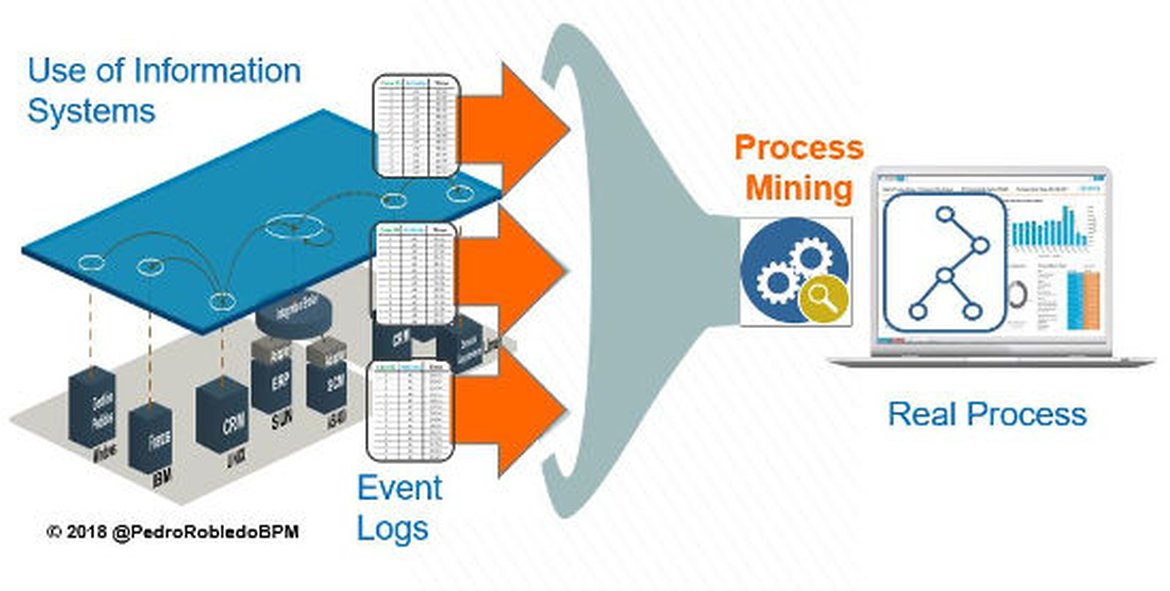
Process Mining is a process analysis method that aims to discover, monitor and improve real processes (processes not assumed) by extracting knowledge easily from available event logs in the systems of current information of an organization. It goes beyond the pure presentation of the key data of the process, recognizing the contextual relationships of the processes, presenting them in the form of graphic analysis in order to diagnose problems and suggest improvements in the quality of the process models. With Process Mining it will be possible to detect or diagnose problems based on facts and not on conjectures or intuitions. Process mining seeks the confrontation between event data (observed behavior) and process models (hand-made or automatically discovered). Through the pairing of event data and process models, it will be possible to check compliance, detect deviations, predict delays, support decision making and recommend process redesigns.
Gartner began reporting on process mining in 2008 as "Automated Business Process Discovery" (ABPD). The Institute of Electrical and Electronic Engineers (IEEE) Task Force on Process Mining, established in 2009, published a Manifesto in late 2011 to promote process mining as a new tool to improve the (re)design, control and support of the business operating processes. Around the same time, one of the fathers of process mining, Professor Wil van der Aalst, published the first book on process mining in 2011 that has recently been updated under the title "Process Mining: Data Science in Action" edited by Springer (recommended reading).
The application of Process Mining in an organization offers the following capabilities:
- Automated discovery of process models, exceptions and instances of processes (cases) together with basic frequencies and statistics.
- Automated discovery and analysis of customer interactions, as well as alignment with internal processes.
- Understanding of different perspectives on operations, not just a process perspective.
- Monitoring of key performance indicators using dashboards in real time.
- Compliance verification capabilities and gap analysis
- Predictive analysis, prescriptive analysis, scenario testing and simulation with contextual data.
- Improvement of existing or previous process models using additional data from saved records.
- Data preparation and data cleansing support.
- Combination of different process models that interact with each other in a single process mining panel.
- Support for the visualization of how processes contribute to business value (such as business operating models) - contextualization of processes.
- Effective cooperation between Business and IT.
- Standardization of business processes.
- Improvement of operational excellence by optimizing processes.
Process mining exploits the information recorded in event logs to perform an analysis of the real process afterwards. There are three main types of process mining:
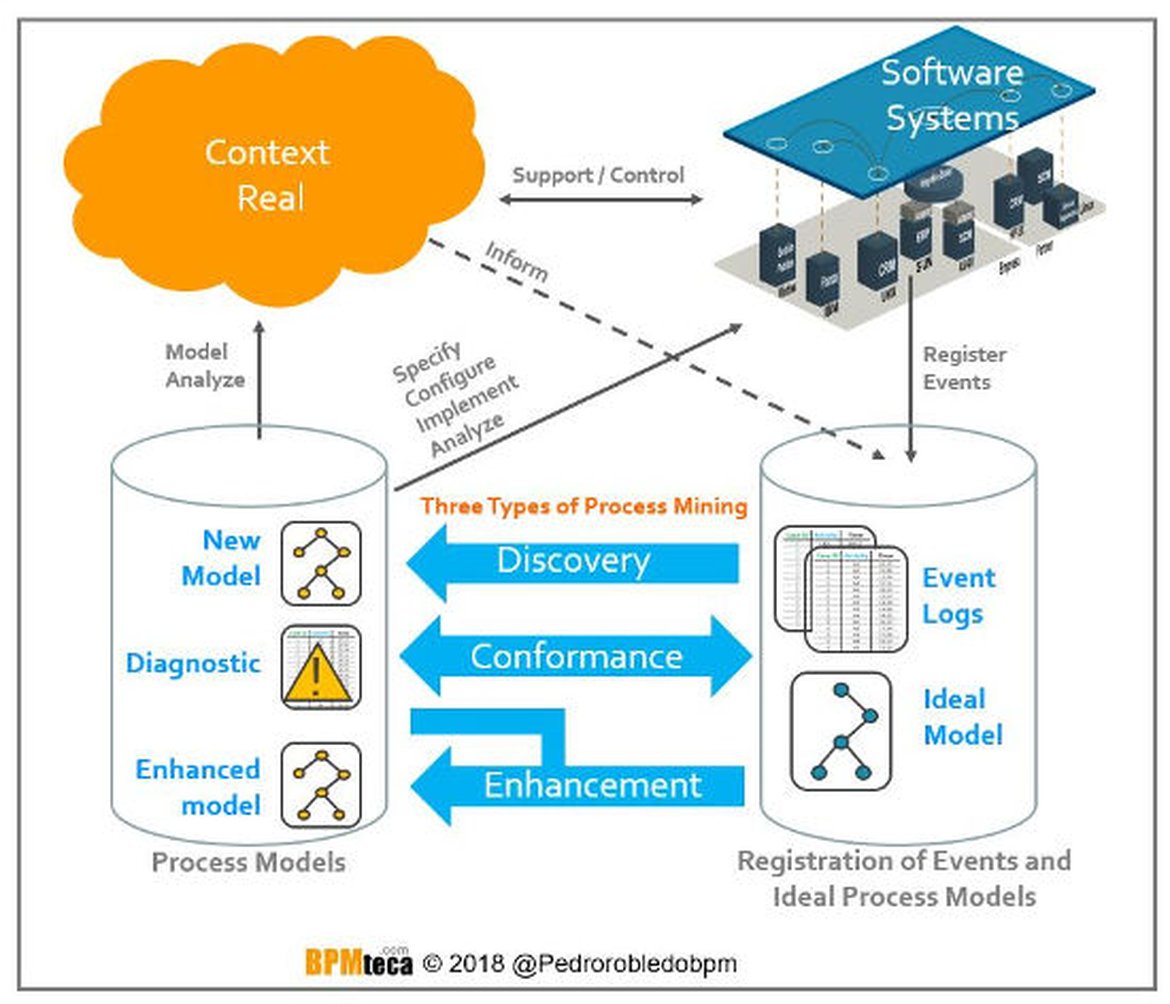
- Discovery, which takes an event log and produces a process model without using any prior information, only with the help of Process Mining algorithms.
- Conformance, where the event records (real processes) and the corresponding process models (ideal and predefined processes in BPMN) are compared, and the resulting coincidences or differences are identified, in order to diagnose the deviations or inefficiencies between the process model derivative business and ideal processes.
- Enhancement (extension), where the process models are adapted and improved according to the data of the real process.
Process mining consists of two main steps:
- Step 1: Process selection and prioritization, which clearly establishes the improvement objectives and identifies where the business value is created in different parts of the organization and how high-level processes affect the creation of value.
- Step 2: capture of the process information to be improved to represent it as a process model.
Santiago Aguirre provides, in his book "Process Mining: Fundamentals and Methodology of Application", a methodology of application of process mining with Process Mining solutions with the aim of redesigning and improving business processes. The methodology consists of four stages (project definition, data preparation, process analysis and process redesign), and each of these stages is divided into certain concrete steps, making a 19-step methodology as shown in the following figure:

ResearchandMarkets in the study "Process Analytics Market by Process Mining Type (Process Discovery, Process Conformance & Process Enhancement) - Global Forecast to 2023", explains that the global process analytics market size is expected to grow from USD 185.3 million in 2018 to USD 1,421.7 million by 2023, at a Compound Annual Growth Rate (CAGR) of 50.3% during the forecast period. According to the analyst, the implementation of Digital Transformation is driving the awareness of users to analyze and understand business processes, and the arrival of the algorithmic business are the main factors that drive the process analytics market. In the study, we reach several conclusions regarding the implementation of Process Mining at a geographical level:
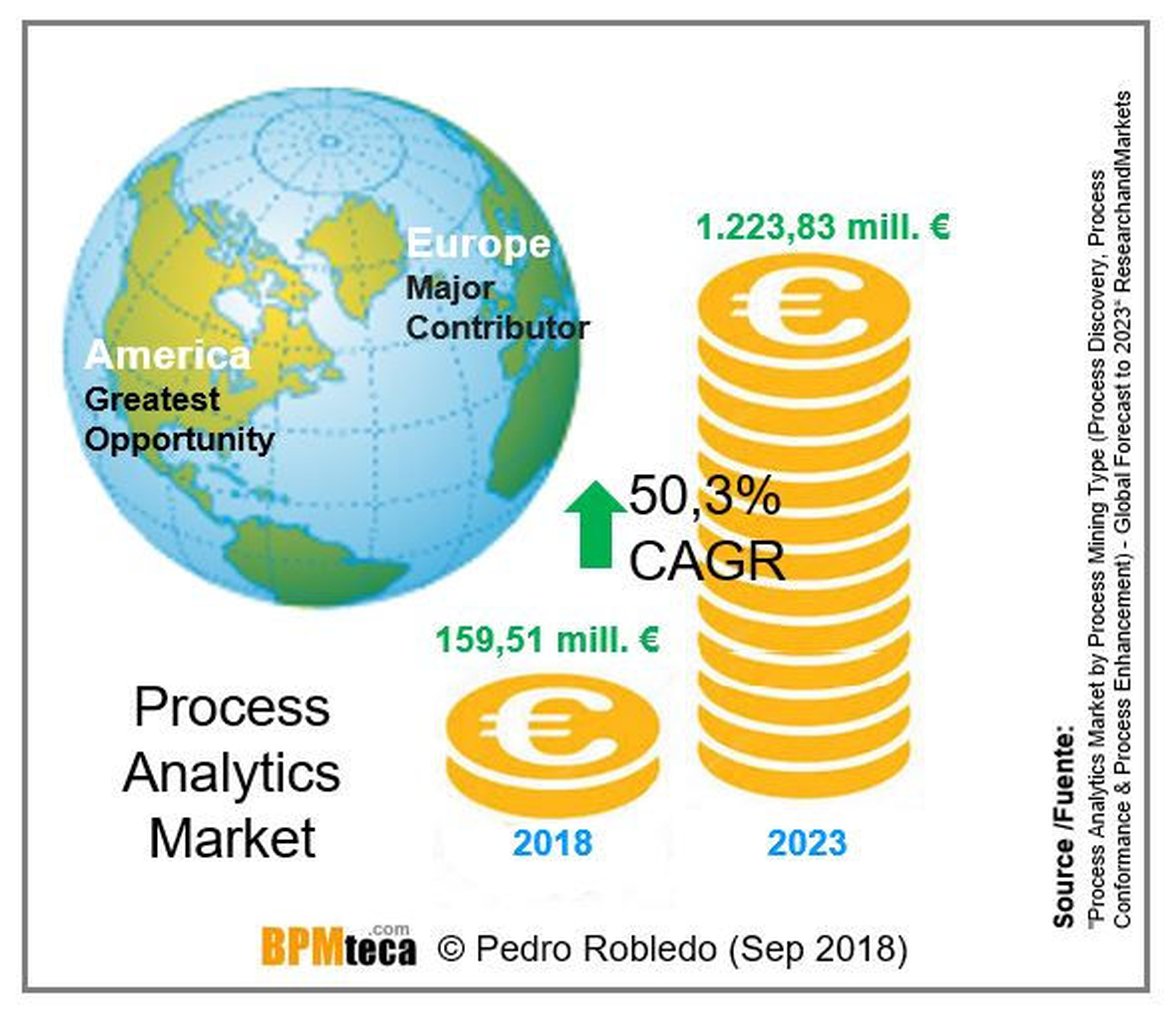
- Europe represents the largest market size due to the widespread acceptance of innovations and the upcoming analytics technology among the large number of Process Mining software vendors operating in the region (see map of vendors). Germany and the Netherlands are the top countries contributing to the process analytics market in Europe.
- North America shows the highest growth rate, representing the greatest opportunity in the process analysis market.
Analyzing the map of Process Mining solution providers in the market located by their countries of origin, we see that Germany, the Netherlands and the United States are the main countries that offer Process Mining solutions.
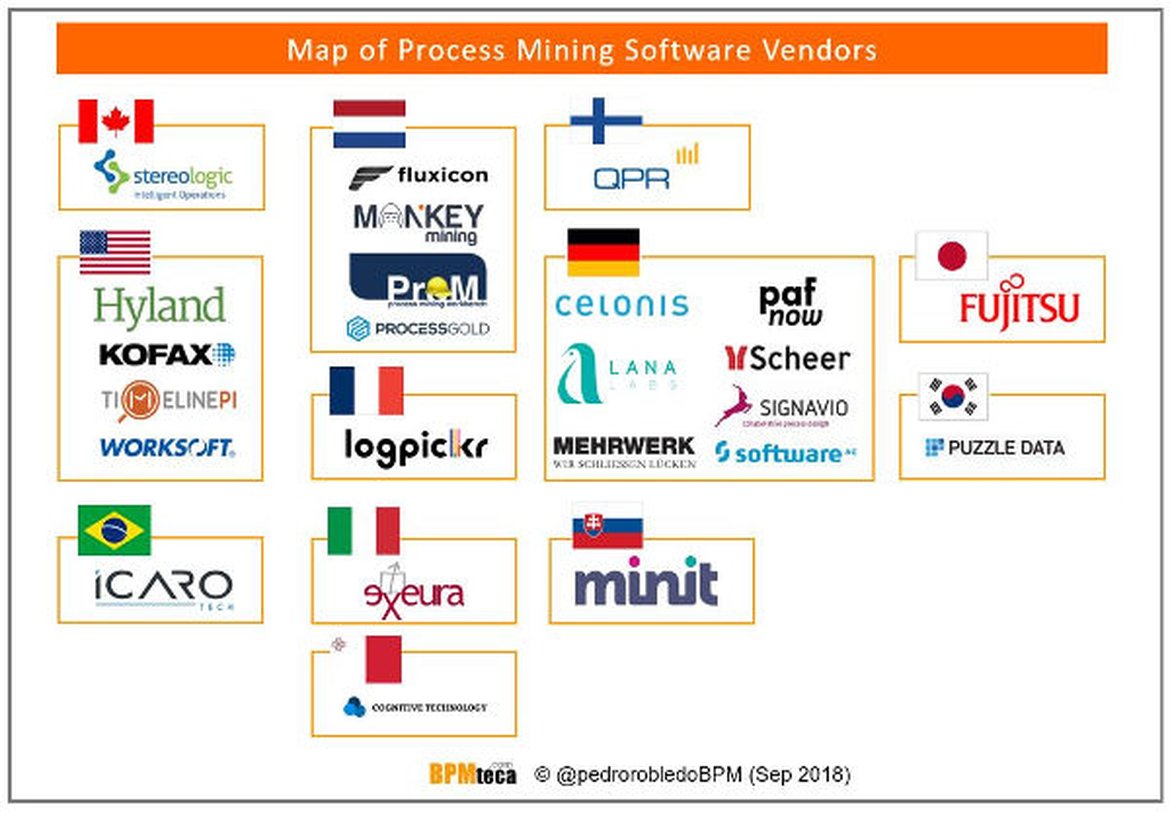
Celonis is surely the market leader in process mining, and Fluxicon Disco being the most popular independent tool in this business.
Many solutions have come out of the university environment, mainly because the scientific origin of process mining has led to many students’ research projects in many universities around the world, demonstrating its value to organizations and therefore, its business application. Thus, the Eindhoven University of Technology, has the free solution ProM (recommended to start in Process Mining) which is the result of the prototypes of several research projects under the tutelage of Professor Wil van der Aalst. And the doctors in Process Mining of that university, Anne Rozinat (first to work in conformances verification and process mining with data recognition) and Christian W. Günther (developed discovery techniques capable of dealing with semi-structured processes and he was the first to add animations based on tokens to discovered process models), decided to create a commercial solution and set up the company Fluxicon.
The following figure highlights that the growing business of Process Mining has led to the creation of companies dedicated to this business mainly after 2008, and some traditional BPM vendors (previously founded) have also been interested in providing their own commercial solution of process mining. Regarding the size of the vendors by number of employees, companies with 11 to 50 employees predominate.
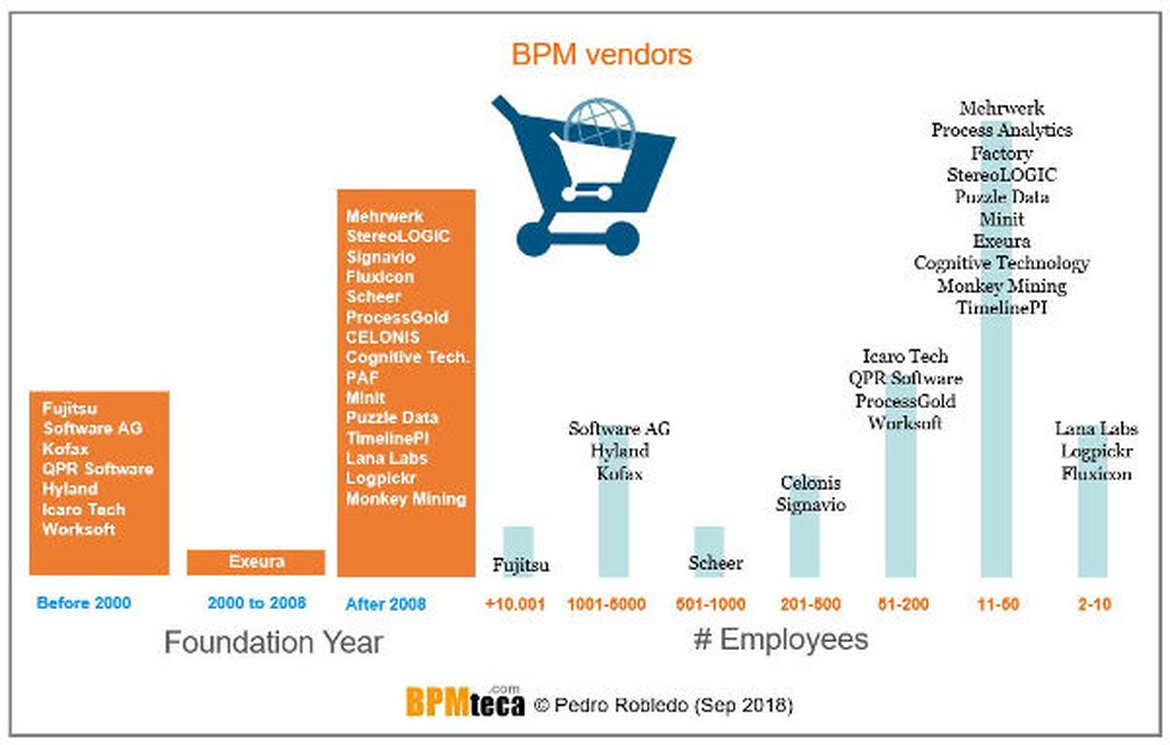
The following table provides a list of Process Mining solution providers in the market, ordered alphabetically:
|
Vendor |
Origin |
web |
Solution |
|
CELONIS |
Germany |
Celonis Process Mining |
|
|
Cognitive Technology |
Malta |
myInvenio |
|
|
Exeura |
Italy |
Rialto Process |
|
|
Fluxicon |
Netherlands |
Disco |
|
|
Fujitsu |
Japan |
Interstage Process Analytics |
|
|
Hyland |
USA |
Perceptive Process Mining (Reflect) |
|
|
Icaro Tech |
Brazil |
EverFlow |
|
|
Kofax |
USA |
Kofax Insight |
|
|
Lana Labs |
Germany |
LANA Process Mining — Magellanic |
|
|
Logpickr |
France |
Logpickr Process Mining |
|
|
Mehrwerk |
Germany |
MPM Mehrwerk Process Mining |
|
|
Minit |
Slovakia |
Minit |
|
|
Monkey Mining |
Netherlands |
Monkey Miner |
|
|
Process Analytics Factory |
Germany |
PAFnow |
|
|
Process Mining Group |
Netherlands |
ProM, ProM Lite, y RapidProM |
|
|
ProcessGold |
Netherlands |
ProcessGold |
|
|
Puzzle Data |
Korea |
ProDiscovery |
|
|
QPR Software |
Finland |
QPR ProcessAnalyzer |
|
|
Scheer |
Germany |
Scheer Process Mining |
|
|
Signavio |
Germany |
Signavio Process Intelligence |
|
|
Software AG |
Germany |
ARIS Process Mining |
|
|
StereoLOGIC |
Canada |
StereoLOGIC Enterprise Discovery Suite |
|
|
TimelinePI |
USA |
TimelinePI |
|
|
Worksoft |
USA |
Worksoft Analyze |
The Digital Transformation normally produces three main changes in an Organization: change of the offer of products and services; change of the value chain; and change of the business model. In order to execute the new value chain that produces the new offer of products and services to satisfy the new business model, it forces organizations to review all current processes to make the necessary changes to achieve digital transformation. The ignorance of the real processes of organizations, makes Process Mining as a process analysis solution that is interesting for both public and private organizations. Process Mining will provide visibility and understanding of the actual performance of business operations and processes before beginning any initiatives to redesign and automate processes, and through analysis to detect opportunities within the context of digitization. The different Process Mining software vendors offer solid solutions that facilitate the discovery of business processes through the event logs of the information systems that are being used in organizations.
RELACIONADO
-
Differences between Processes, Procedures and Work Instructions
by 4 Dec. 7, 2017
-
Managing the customer experience is general value for the brand
by 4 Sept. 6, 2018
-
Does your company have a Digital Culture?
by 4 Dec. 17, 2018
-
Industry 4.0: the bpm challenge
by 4 July 9, 2017
-
Before automating a process ... improve it!
by 4 Jan. 8, 2020
-
Not enough with an independent Management of a Process
by 4 May 9, 2017
-
How to guide organizations in Maturity in BPM?
by 4 March 16, 2019
-
Why BPM is vital for companies in the energy and utility industry
by Albatian July 13, 2020
-
Process Digitalization in Digital Transformation
by Albatian Jan. 9, 2017
-
Why BPM is Vital for Insurance Companies
by 4 Feb. 22, 2021
-
Gestión del Conocimiento como Estrategia Empresarial
by 4 Feb. 22, 2021
-
BPM is key to the Digital Transformation
by Albatian Oct. 4, 2016
-
BPM is the most effective discipline of business management
by Albatian Sept. 15, 2016











